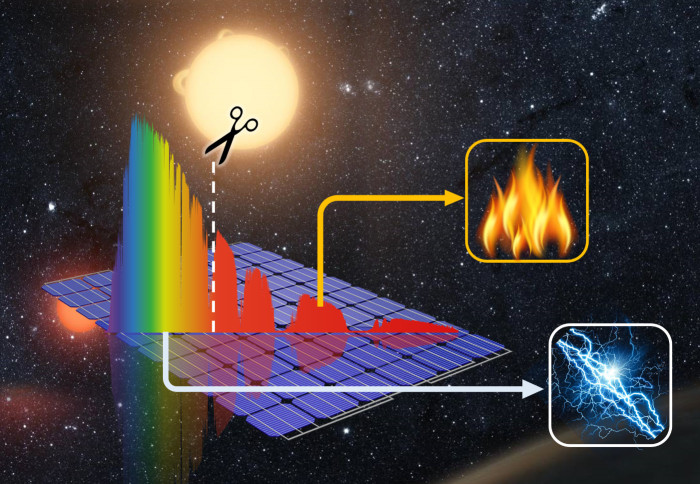
Concept of spectral-splitting PV-thermal technology

According to a new study, solar collectors that split sunlight are significantly more efficient at generating combined thermal and electrical energy.
Spectral-splitting photovoltaic-thermal solar collectors are an emerging technology used for harvesting solar energy that work by directing different parts of the solar spectrum to suitable receivers. This energy is then converted into both electricity and heat simultaneously.
"Our research is significant because it provides the groundwork for understanding spectral-splitting photovoltaic-thermal collectors, along with practical guidance on how to apply this knowledge." Dr Gan Huang
Solar energy is one of the most abundant renewable energy sources, and effective solar technologies have great potential to alleviate the grand challenge of rising global energy demand while reducing associated emissions.
In research published today in Light: Science & Applications, researchers from the Clean Energy Processes Laboratory found that, when optimised, spectral-splitting photovoltaic-thermal solar collectors convert a wider range of the solar spectrum to useful energy, which would otherwise be lost to the environment.
This research demonstrates the increased potential of solar technologies in clean energy applications and promotes their use in industry and homes.
Frameworks for optimising efficiency
Spectral-splitting photovoltaic-thermal collectors are a promising new technology with a significantly improved potential for efficient solar energy harvesting. While traditional photovoltaic (PV) panels and solar-thermal collectors generate electricity and thermal energy respectively, spectral-splitting photovoltaic-thermal solar collectors produce and deliver both types of energy simultaneously without compromising efficiency.
However, there is a lack of consensus within the field as to their optimal design, operating conditions and ultimate potential.
For the first time, researchers at Imperial College London have produced a framework based on a combination of photovoltaic, thermodynamic and thermal principles for the technology. It provides detailed guidance for selecting optimal designs, PV cell materials and spectral-splitting filters, which can be used to predict their performance and identify efficiency limits. This will enable designers to tailor such collectors to their intended use.
The team found that the choice of PV material and spectral-splitting filter has the most significant impact on the efficiency of these collectors. Furthermore, their work shows that different types of PV cells and filters are better suited to certain environments.
To aid technology designers, developers, installers and operators, the team have turned their data into detailed performance maps that can be used to achieve the best overall performance.
Next-generation solar energy technologies
Lead author Dr Gan Huang said: “Our research is significant because it provides the groundwork for understanding spectral-splitting photovoltaic-thermal collectors, along with practical guidance on how to apply this knowledge.
“These solar collectors are able to direct different parts of the solar spectrum to PV cells for electricity generation and to a thermal absorber for heat generation, thus maximising their overall solar utilisation and conversion efficiency.”
"This technology has the potential to be a more resource-efficient and space-effective solution for harnessing solar energy, something that will be vital as we transition to a clean energy future". Professor Christos Markides
The head of Clean Energy Processes Laboratory and principal investigator Professor Christos Markides added: “We have demonstrated that, if designed and operated appropriately, spectral-splitting photovoltaic-thermal collectors always have a higher efficiency than any combination of conventional solar PV panels and solar-thermal collectors.
“This is an important conclusion, as it suggests that this technology has the potential to be a more resource-efficient and space-effective solution for harnessing solar energy, something that will be vital as we transition to a clean energy future, especially in constrained spaces."
Next steps
Using the results of this study, the Clean Energy Processes Laboratory is focusing on developing high-performance designs and advanced optical materials for spectral-splitting solar collectors that are tailored for use by a wide variety of users in diverse applications, and in different weather conditions across distinct global regions.
-
‘Efficiency limits of concentrating spectral-splitting hybrid photovoltaic-thermal (PV-T) solar collectors and systems’ by Gan Huang, Kai Wang & Christos N. Markides is published in Light: Science & Applications.
-
This work was supported by the UK Engineering and Physical Sciences Research Council (EPSRC) (grant numbers EP/M025012/1 and EP/R045518/1) and by an Imperial College London EPSRC Impact Acceleration Account (grant number EP/R511547/1). The authors would also like to thank UK company Solar Flow Ltd.
Supporters

Article text (excluding photos or graphics) © Imperial College London.
Photos and graphics subject to third party copyright used with permission or © Imperial College London.
Reporter

Sara West
Communications Division



